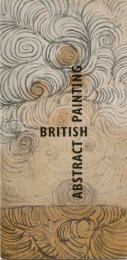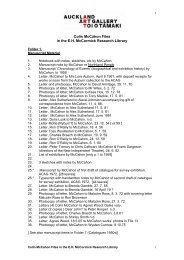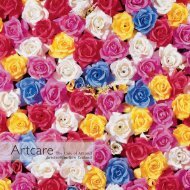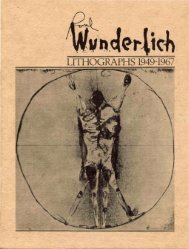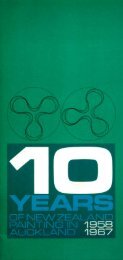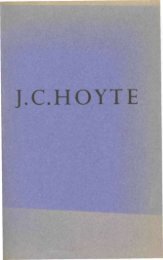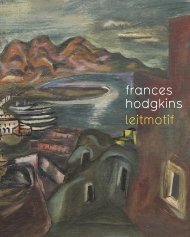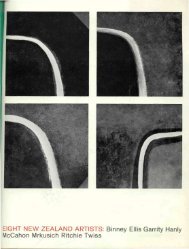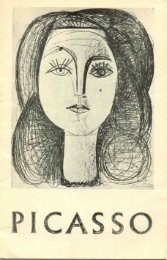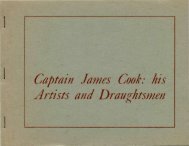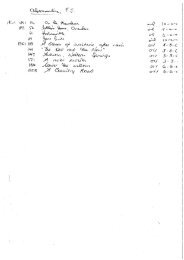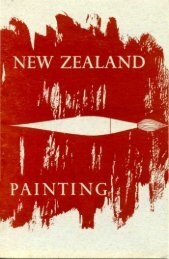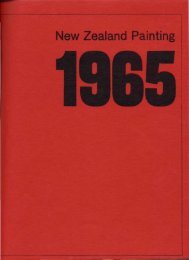EPSTEIN - Auckland Art Gallery
EPSTEIN - Auckland Art Gallery
EPSTEIN - Auckland Art Gallery
- No tags were found...
You also want an ePaper? Increase the reach of your titles
YUMPU automatically turns print PDFs into web optimized ePapers that Google loves.
1ifo*ry~'<strong>EPSTEIN</strong>AUCKLAND CITY ART GALLERY
Jacob Epsteindrawings and sculpture<strong>Auckland</strong> City <strong>Art</strong> <strong>Gallery</strong>March-April 1961
FOREWORDSir Jacob Epstein died in 1959. This exhibition has been arranged tocommemorate his life work. Although no large works are included, itrepresents his art from his early years to the Cavendish SquareMadonna. This is also the first exhibition to be devoted entirely to thesculptor's work in the Antipodes, so that the works here will serve adouble service — they will be both a memorial and an introduction to avery great artist.Jacob Epstein, like Manet before him, withstood the onslaught ofpublic opposition to progress in contemporary sculpture in Britain. Hisintegrity, his honesty and artistic powers, gave him the necessarycourage. We hope that this exhibition will provide ample evidence ofthe humanity and great sculptural sensibility of Sir Jacob Epstein.We owe a particular debt of gratitude tc^fLady Kathleen Epstein forher Introduction and for her generous loans and help. To Mr ArnoldHaskell and Mr K. Webster we are also most grateful for the loan of somany works. Our thanks are due as well to the other private and publiclenders included in the index at the end of this catalogue.P. A. TomoryMarch, 1961
INTRODUCTIONIt seems fitting that Jacob Epstein's sculpture is to be exhibited in theland of the tiki carvers, for no one loved and studied these beautifulgreenstone carvings more ardently than he. Is it fanciful to hope thatdescendants of these carvers may now look at his work with somethingof the same interest? He loved all fine Maori work and had manyexamples in his fabulous collection of primitive sculpture.I am surprised when I see what a widely representative exhibition ofEpstein's work has been collected in such a short time for this <strong>Auckland</strong>showing. The dates speak for themselves. Starting in 1898 with drawingsnever, I am sure, seen by the public before, we go through the earlyyears of the century, through the twenties, thirties and forties until wereach the maquette for the Cavendish Square Madonna, 1952, sevenyears before the sculptor's death. So that specimens of a life's work arerepresented hers, though of course this selection of bronzes and drawingsis only a very small portion of the hundreds of bronzes, carvingsand drawings made by this most prolific artist. There is only one seriousomission and it is unavoidable. No carvings are available for thisexhibition, and yet carving is a vital factor in his work. Starting withthe eighteen overlife-size carved figures for the B M A building in theStrand (1908), there followed the Oscar Wilde tomb (Paris, 1912), aseries of carvings in marble and flenite — 'Adam', 'Genesis', 'Night andDay', 'Ecce Homo', 'Lazarus', and the TUC Memorial in Bloomsbury.This was Epstein's last carving, worked 'in situ' on the inner wall ofthe building when he was seventy-seven years old. It is visited bypeople from all parts of the world. It will be seen from this howimpossible it has been to obtain carved work for the exhibition, the fewpieces that still remain in private hands being retained for the EdinburghFestival Memorial Exhibition later this year.Through the enterprise of Mr Tomory, the <strong>Auckland</strong> <strong>Art</strong> <strong>Gallery</strong> hasacquired in 'The Rock Drill' one of Epstein's most imaginative compositions.I am happy to have been able to have this cast in bronze intime for the present show, and it is good to know that it will becomepart of the <strong>Gallery</strong>'s permanent collection. Not only is it a technicalachievement but, when one considers the period in which it was conceived(1912), one sees that it was a pioneer work with somethingprophetic in its symbolism. The somewhat sinister robot man containswithin himself the embryo child whom he may eventually destroy. Inthe original sketch the machine burrows into the earth, seeking out thesecrets which could finally destroy the human race. The sculptor decidedthat the purely mechanical lower section was not truly sculptural andcast only the human part as it stands today.As for the other bronzes displayed here, I can only say that in theEinstein, Vaughan Williams and Esther portraits, Epstein reached thezenith of his power as a portrait sculptor. The heads of those two
famous men have been acclaimed all over the world, while thesculptor himself used to say that if he had to be judged on the meritsof any one work, he would choose one of the portraits of his daughterEsther. His outstanding gift for sculpturing children could not be betterexemplified than by 'The Sick Child' (1928), modelled from hisdaughter Peggy Jean. I think attention should be drawn to the exquisitesensitivity of the hands in this study and also to the tragedy of thehands in 'The Weeping Woman' (1922), for Epstein was a master ofthe sculptured hand and no artist studied more closely the relationshipof head and hand and its power of expressing mood and character.It is impossible in a short foreword to write about Epstein's qualitiesas a sculptor. Others far better fitted than I have already done this, andat this moment a serious and comprehensive study of his sculpture isbeing prepared. But I would like to write of one personal observationwhich always impressed me. During the many years I knew him healways worked six days a week for nearly every week during theyear, and it was the hardest job to persuade him to take a holiday.Yet never once did I see him start a new work without the greatestexcitement. If it were a portrait, commissioned or otherwise, his sitterwould always be awaited with the nervous tension of one engaged onhis first portrait, and this would be sustained for the duration of thework. His studio was kept locked, and each morning he would open itwith the eager anticipation of another glorious day's work. On the nightof August 19, 1959, he went to the studio to take another look at thegroup he had finished that morning, and five minutes later he died.Kathleen EpsteinFebruary 1, 1961Biographical Chronology1880 Born of Russian-Polish parents in Hester Street, East Side, NewYork.1888-1900 Made many drawings of New York life and Jewish types, andillustrated 'The Spirit of the Ghetto' by Hutchins Hapgood. Begansculpture at night classes under George Grey Barnard.1902 Hapgood's book published. Used the fees for the illustrations topay his fare to Paris. Studied first at the 'Ecole des Beaux <strong>Art</strong>s' andthen at, Julian's.1905 Moved to London. Took a studio at 219 Stanhope Street, CamdenTown. Visited New York, but returned at once and took a studio atFulham.1907 Commissioned to carve 18 figures for the British Medical Association'sbuilding in Agar Street, Strand, London. Moved to Cheyne Walk.-1
1956 'Bishop Woods Memorial', Litchfield Cathedral. 'Field MarshalSmith', Parliament Square, Westminster.1957 'Lewis Building', Liverpool, an overlife size figure and 13 bas reliefpanels. 'Blake Memorial', Westminster Abbey.1957-8 'St Michael and the Angel'.1958-9 'Bowater House Group'. Five figures in bronze.Died London, 1959.List of SourcesThe short form in which these sources are referred to in the catalogueis given in brackets under the entry.BLACK, Robert: 'The <strong>Art</strong> of Jacob Epstein', The World Publishing Co.,New York, 1942 (Robert Black).DEIREN, Bernard Van: 'Epstein', John Lane, London, 1920 (VanDieren).'Dictionary of National Biography', Oxford, 1950.<strong>EPSTEIN</strong>, Jacob: 'Let there be Sculpture', an autobiography, MichaelJoseph, London, 1940.<strong>EPSTEIN</strong>, Jacob: 'An Autobiography', Hulton Press, London, 1955(Autobiography).'Epstein: <strong>Art</strong>s Council of Great Britain', an exhibition held at the Tate<strong>Gallery</strong>, September 25 to November 9, 1952, Catalogue (<strong>Art</strong>s Council,1952).'Epstein: Bronzes and Drawings from the Arnold F. Thompson Collection,Nottingham', Derby; Leicester 1959-1960 Catalogue (Thompson,1959).'Epstein-Sickert', May 14 to June 14, 1954, Queensland National <strong>Art</strong><strong>Gallery</strong> Catalogue.'Everymans Encyclopaedia', J. M. Dent & Sons, London, 1958.'Fifty Years of Bronzes and Drawings by Sir Jacob Epstein', LeicesterGalleries, London, 1960 Catalogue. (Leicester Galleries, 1960.)HASKELL, Arnold: 'The Sculptor Speaks', Heinemann, 1932 (Haskell).WELLINGTON, Hubert: 'Jacob Epstein', Ernest Benn, London, 1925(Wellington).i>
THE CATALOGUEMeasurements of the sculptures are not given as unless otherwise statedthe works are life size.Measurements of the drawings are given in inches, height before width.1MAN WITH MICE AND BIRD c 1898Pencil drawing 23ix16§ Signed 'Epstein'Lent by Mr K. Webster2WORKMEN AT LUNCH c 1898Pencil drawing 214 x 17J Signed 'Jacob Epstein'Lent by Mr K. Webster3SWEAT SHOP c 1898Pencil drawing 244x20 Signed 'Epstein'Lent by Mr K. WebsterMy earliest recollections are of the teeming East Side [New York] whereI was born.This Hester Street and the streets surrounding it were the most denselypopulated of any city on earth. . . . Wherever one looked there wassomething interesting, a novel composition, wonderful effects of lightingat night, and picturesque and handsome people. Rembrandt would havedelighted in the East Side. . . . (Autobiography, pp. I and 8)4EUPHEMIA LAMB 1908BronzeLent by Lady Kathleen EpsteinThis bust is not included in the catalogue of works listed in 'Haskell' or'Black*, but appears under the date given above in the catalogue ofEpstein's first exhibition at the Twenty One <strong>Gallery</strong>, London, 1913. Afull bust of the sitter was formerly in the Eumorfopoulos collection andis illustrated in 'Van-Dieren', plate 27. See also 'Robert Black', plates82 and 83.5MRS AMBROSE McEVOY 1910BronzeLent by Lady Kathleen EpsteinThe wife of Ambrose McEvoy the artist, (1878-1927), nee Mary SpencerEdwards.See 'Robert Black', plate no. 74; Haskell, p. 167, and 'Wellington'.7
had the desire to train myself in a more intensive method of working;and with that in view, 1 began a series of studies from the model, whichwere as exact as I could make them. . . . Also at that time I did a bust ofMrs Ambrose McEvoy. . . . (Autobiography, p. 42)6NAN 1911BronzeLent by the Queensland National <strong>Art</strong> <strong>Gallery</strong>Nan Condron, a gypsy model. Listed 'Howell', p. 168; illustrated VanDieren, plate 154.An earlier bust of this same model dates from 1903 in both draped andundraped versions, the former illustrated 'Autobiography' facing page38. 'The Dreamer' of 1911 is a further portrait of the same model.7THE ROCK DRILL 1913Bronze Ht 2' 4"<strong>Auckland</strong> City <strong>Art</strong> <strong>Gallery</strong>Other casts of this sculpture are in the Tate <strong>Gallery</strong>, London, theMuseum of Modern <strong>Art</strong>, New York, and the Ottawa Museum, Canada.Listed 'Robert Black', p. 229, illustrated plate no. 14; 'Howell', p. 170.Illustrated 'Van Dieren', plate no. 13, also 'Wellington'. Exhibited '<strong>Art</strong>sCouncil', 1952, cat. no. 8; 'Sources of the Twentieth Century', theCouncil of Europe, 1960.•It was in the experimental pre-war days of 1913 that I was fired to dothe rock drill, and my ardour for machinery expended itself on thepurchase of an actual drill, second hand, and upon this I made andmounted a machine-like robot, visored, menacing, and carrying withinitself its progeny, protectively ensconced. Here is the armed sinister figureof today and tomorrow. . . . Later I lost my interest in machinery anddiscarded the drill. I cast in metal only the upper part of the figure.(Autobiography, p. 56)8MRS JACOB <strong>EPSTEIN</strong> (MASK) 1916BronzeLent by Mr Arnold F. ThompsonA cast of this mask with long earrings is in the collection of the ManchesterCity <strong>Art</strong> <strong>Gallery</strong>.Listed 'Robert Black', p. 230, illustrated plate 7; 'Haskell', p. 172.Illustrated 'Van Dieren', plate 15; 'Autobiography', facing page 66; and'Wellington', plate 14. See also 'Let there be sculpture', 'Jacob Epstein',published 'Michael Joseph Ltd', 1940. Exhibited '<strong>Art</strong>s Council', 1952(the Manchester cast), cat. no. 11; 'Thompson', 1959, cat: no. 1.In this mask, 1 immediately made what I think is one of my subtlest andmost beautiful works. The serenity and inward calm are there, and from8
the point of view of style, the simplicity is that achieved loy antiquesculpture. I can recall that 1 worked at this mask without effort, achievingit happily, and was pleased with the result. 'Autobiography, p. 96)9THE TIN HAT 1916BronzeLent by Lady Kathleen EpsteinAnother cast of this head is in the Imperial War Museum, London.Listed 'Haskell', p. 172; 'Robert Black', p. 230, illustrated plates 37 and91; also illustrated 'Van Dieren', plate 23. Exhibited Leicester Galleries,1960, cat. no. 10.9
10THE AMERICAN SOLDIER 1917BronzeLent by Mr Arnold F. ThompsonAnother cast of this sculpture is in the Metropolitan Museum, New York.Listed 'Haskell', p. 173; 'Robert Black', p. 231, illustrated plate 8; alsoillustrated 'Van Dieren', plate 25. Exhibited Leicester Galleries, 1920;'Thompson', 1959, cat. no. 2.11SMALL HEAD OF MEUM 1917BronzeLent by the <strong>Art</strong> <strong>Gallery</strong> of New South WalesA portrait of Meum Lindsell-Stewart ,Listed 'Haskell', p. 173; 'Robert Black', p. 231. Exhibited 'Exhibitionof British Contemporary <strong>Art</strong>', Melbourne, Sydney, 1933, cat. no. 182;ii10
'Epstein-Sickert', May-June 1954, Queensland National <strong>Art</strong> <strong>Gallery</strong>,Australia, cat. no. 1. As well as this head and the mask (cat. no. 11)Epstein made two other sculptures of Meum Lindsell-Stewart: 'FirstBust of Meum', 1916, and 'Meum with a Fan', 1918. Illustrated 'RobertBlack', plate 52; 'Van Dieren', plate 38.12MASK OF MEUM 1918BronzeLent by Mr Arnold L. Haskell, C B EFurther casts are in the collections of Mr Alfred C. Blossom, M P,F R I B A, and the <strong>Art</strong> Institute of Chicago.Listed 'Haskell', p. 175; 'Robert Black', p. 232, and illustrated plate 92;illustrated 'Van Dieren', plate 49, 'Wellington' and 'Autobiography',facing page 55. Exhibited 'Leicester Galleries', 1920, and 1960 cat. no. 13(illustrated); '<strong>Art</strong>s Council', 1952, cat. no. 13, plate 12.13A WOUNDED SOLDIER 1918Pencil 18x14 Signed and inscribed 'Epstein Salisbury Road MilitaryHospital July 1918'Lent by Mr Arnold L. Haskell, C B E14THE WEEPING WOMAN 1922BronzeLent by the Leicester Museum and <strong>Art</strong> <strong>Gallery</strong>The model for this bust, which was intended for a group, the 'Descentfrom the Cross', posed for the painter Whistler in her youth.Listed 'Haskell', p. 179; 'Robert Black', p. 234, illustrated plate 15.Illustrated 'Wellington'. Exhibited 'Leicester Galleries', 1924; '<strong>Art</strong>sCouncil', 1952, cat. no. 19.15ELSA LANCHESTER 1924BronzeLent by Mr Arnold L. Haskell, C B EElsa Lanchester is the actress wife of Charles Laughton.Listed 'Haskell', p. 182, and illustrated facing page 112. Listed 'RobertBlack', p. 235. Exhibited 'Leicester Galleries', 1924.16EVE DERVICH 1924BronzeLent by the City of Mildura <strong>Art</strong> <strong>Gallery</strong>Listed 'Haskell', p. 182; 'Robert Black', p. 235. ExhibitedGalleries', 1924.'Leicester11
17SUNITA AND ANITA c 1925Pencil 19|x21} Signed 'Epstein'Lent by Mr Arnold F. ThompsonOne of a series of eight pencil drawings, 'The Sleepers'. Exhibited'Thompson', cat. no. 19.18RABINDRANATH TAGORE 1926BronzeLent by Mr Alexander MarguliesFurther casts of this portrait are in the collection of the National <strong>Gallery</strong>of Victoria, Melbourne, and the Birmingham City <strong>Art</strong> <strong>Gallery</strong>.Listed 'Haskell', p. 186; 'Robert Black', p. 236. Illustrated 'Autobiography',facing page 86; Sculpture: Theme and Variations, E. H.Ramsden, Lund Humphries, London. 1953, plate 42. Exhibited '<strong>Art</strong>sCouncil', 1952. cat. no. 25 (plate 23); 'Leicester Galleries', 1960, cat. no.22.Sir Rabindranath Tagore (1861-1941) was the most notable Indian writerof the whole period of British administration in India. A lyrical poetinspired by the wonder of the created world, he strove to bridge the gapbetween the cultural and religious beliefs of East and West. Tagoremade a deep impression on the English public, and a 'drawing room'cult rapidly grew around the 'poet-seer', somewhat diminishing hisserious reputation.The 'Gitanjali', a collection of poems, was his first work published inEngland; it appeared with an introduction by W. B. Yeats in 1912. In1913 Tagore was awarded the Nobel prize for literature. He wasknighted in 1915 and four years later he sought to renounce his knighthoodas a protest against English domination of India.'I am he that sitteth among the poorest, the loneliest, and the lost.' Thisquotation from Gitanjali was strongly contradicted by my sitter, whosehandsome, commanding presence inspired in his followers awe and acraven obedience. . . . The manners of Tagore were aloof, dignified andcold, and if he needed anything only one word of command escaped himto his disciples. It has been remarked that my bust of him rests upon thebeard, an unconscious piece of symbolism. (Autobiography, p. 92)19SUNITA c 1926Charcoal drawing 21i x 18£ Signed 'Epstein'<strong>Auckland</strong> City <strong>Art</strong> <strong>Gallery</strong>Sunita, an Indian woman, was, with her son, Epstein's model for the'Madonna and Child' of 1926, and also for a head and a bust made in1925, a bust in 1926, and the 'Sunita Reclining' of 1931. (See Autobiography,p. 123.) Illustrated 'Haskell', facing p. 4.n
20THE SICK CHILD 1928BronzeLent by Mr Arnold L. Haskell, CBEThe artist's daughter, Peggy Jean, aged ten yearsListed 'Haskell', p. 187, and illustrated facing page 66p. 237. Illustrated 'Autobiography' facing page 118.Council', 1952, cat. no. 29, plate 28.'Robert Black',Exhibited '<strong>Art</strong>sTwenty years ago 1 would have simplified the hair of the child into whatcritics call 'true sculpture', while today I find a rhythm in the hair ofeach individual head that 1 must capture. (Haskell, pp. 61-62)21NUDEPencil 18x22 Signed 'Epstein'Lent by Mr Arnold F. ThompsonIllustrated 'Epstein, 75 Drawings', Saville, 1929, plate 74.22GIRL ON A COUCH c 1928Pencil 18x23 Signed 'Epstein'Lent by the Nottingham <strong>Art</strong> <strong>Gallery</strong>Exhibited 'Thompson', 1959, cat. no. 20.22L3
23A NEGRESS c 1928Pencil and watercolour 17| x 22J Signed 'Epstein'<strong>Auckland</strong> City <strong>Art</strong> <strong>Gallery</strong>24BETTY JOEL 1929BronzeLent by the Dunedin Public <strong>Art</strong> <strong>Gallery</strong> Society Inc.This portrait was extended into the bust 'La Belle Juive' in 1930. (See'Robert Black', plate 34.)Listed 'Haskell', p. 188; 'Robert Black', p. 237.25VISION OF EZEKIEL 1931Pencil and watercolour 23 x 17J Signed 'Epstein'Lent by Mr K. Webster14
2526VISION OF JACOB 1931Pencil and watercolour 22f x 18 Signed 'Epstein'Lent by Mr K. WebsterA sculptor is supposed to he a didl dog anyway, so why should he nothreak out in coloxir sometimes. (Aittohiographx, p. I4i)27BENAIAH AND THE LION 1931Pencil and watercolour 23 x 17g Signed 'Epstein'Lent by Mr K. Webster28JEZEBEL 1930Pencil and watercolour 23x173 Signed 'Epstein'Lent by Mr K. Webster29ABSOLOM'S PILLAR 1931Pencil and watercolour 23 x 171 Signed 'Epstein'<strong>Auckland</strong> City <strong>Art</strong> <strong>Gallery</strong>15
30TO DIVIDE THE LIGHT FROM THE DARKNESS 1931Pencil and watercolour 17J x 22$Lent by Mr A. F. ThompsonThis drawing was used by the sculptor as the study for the bust ofWilliam Blake, now in Westminster Abbey, commissioned for the Blakebicentenary.In 1931 I made a series of drawings for the Old Testament. I becameso absorbed in the text and in the countless images evoked by my readings,a whole new world passed in vision before me. I lost no time in -puttingthis upon paper. When I exhibited them it seemed that 1 had againcommitted some kind of blasphemy, and countless jibes were forthcoming.There is an element in all countries which would suppress the free artist,kill original thoughts, and bind the minds of men in chains. (Autobiography,p. 143)31EPPING FOREST 1933Watercolour 22J x 17 Signed 'Epstein'Lent by Miss Mabel JohnsonDuring the summer of 1933 1 painted nearly a hundred watercolours ofEpping forest. . . . As usual with me, what I started as a mere diversionbecame in the end a passion, and I could think of nothing else butpainting. I arose to paint, and painted until sundown, and when 1 laterexhibited these paintings in a London gallery, it was a source of annoyanceto some critics that I had painted so many. (Autobiography, p. 142)32ALBERT EINSTEIN 1933BronzeLent by Mr Alexander MarguliesFurther casts of this sculpture are in the collections of the Tate <strong>Gallery</strong>,Listed 'Robert Black', p. 240, illustrated plate b2. Illustrated 'Autobiography'facing page 77. Exhibited 'Leicester Galleries', 1933; '<strong>Art</strong>sLondon, and the National <strong>Gallery</strong> of Victoria, Melbourne.Council', 1952, cat. no. 34.Albert Einstein (1879-1955) was born in Germany and educated inSwitzerland, becoming a Swiss citizen in 1901. He took up professorialposts in Zurich and Prague and in 1914 became director of the KaiserWilheim Physical Institute in Berlin, where he remained until 1933when owing to his Jewish origin he was deprived of his post and took/refuge in England, later accepting a professorship at Princetown University.Einstein received the Nobel prize for physics in 1921.Einstein appeared dressed very comfortably in a pullover with his wildhair floating in the wind. His glance contained a mixture of the humane,in
the humorous, and the profound. This was a combination which delightedme. He resembled the ageing Rembrandt. ... I worked for two hoursevery morning and at the first sitting the Professor was so surroundedwith tobacco smoke from his pipe that I saw nothing . . . in speaking ofNazis, he once said: '1 thought 1 was a Physicist, 1 did not bother aboutbeing a Jew until Hitler made me conscious of it.' (Autobiography, pp.77, 78)33LYDIA 1933BronzeLent by Mrs F. Nesbitt'Haskell' and 'Black' list versions of this sculpture made in 1930, 1931and 1933. However, a bust of 'Lydia' illustrated in the 'Autobiography'(facing page 119) is dated 1928; a further cast exhibited at the 'LeicesterGalleries', 1960, is dated 1938 in the catalogue. Exhibited 'Epstein-Sickert', May, June 1954, 'Queensland National <strong>Art</strong> <strong>Gallery</strong>', Australia,cat. no. 5.34BERNARD SHAW 1934BronzeLent by the Queensland National <strong>Art</strong> <strong>Gallery</strong>At Shaw's insistence the original portrait was a full bust (illustrated,plate 8, 'Modern Sculpture', Teaching Portfolio No. 1, Museum ofModern <strong>Art</strong>, New York). The second version uses the head only, setat a slightly different angle (exhibited '<strong>Art</strong>s Council', 1952, cat. no. 35).See also 'Leicester Galleries', 1960, cat. no. 29.George Bernard Shaw, playwright and polemicist, was born in Dublinin 1856. His career as a writer began with such novels as 'Love Amongthe <strong>Art</strong>ists', 'Cashel Bryon's Profession', etc, and he wrote theatre andmusic criticism for various London papers in the 'nineties. His manyplays were at first treated with indifference or contempt by the publicat large, and only later in his life did he achieve success as a playwright.He was a vociferous Fabian and wrote many essays on behalf ofthe Society and its brand of Socialism. Shaw died at the age of ninetyfour.Shaw sat with exemplary patience and even eagerness. . . . In matters ofart he aired definite opinions, mostly wrong. . . . Shaw was puzzled bythe bust of himself and often looked at it and tried to make it out. Hebelieved that I had made a kind of primitive barbarian of him. Somethingaltogether uncivilised and really a projection of myself, rather thanof him. ... I believe this to be an authentic and faithful rendering ofGeorge Bernard Shaw physically and psychologically. I leave out anyquestion of aesthetics, as that would be beyond Shaw's comprehension.. . . Throughout my life in England, Shaw was an outspoken champion17N
for my work, on several occasions giving the great British public livelysmacks on my behalf. (Autobiography, pp. 82, 83)35NIANDA 1935BronzeLent by Mr J. R. McGregorListed 'Robert Black', p. 241. Exhibited 'Epstein-Sickert', May, June1954; 'Queensland National <strong>Art</strong> <strong>Gallery</strong>', Australia, cat. no. 6.36POPPIES 1936Gouache 17 x 22Lent by the National <strong>Art</strong> <strong>Gallery</strong>, Wellington/ had heen asked to paint some blooms by a firm of Dutch dealers in oldmasters. 1 said 1 would paint twenty, and in the end 1 painted sixty. Notcontent with this, I went on painting, giving up sculpture for the timebeing, and painted three hundred more. I lived and painted flowers. Myrooms were piled with flowers and this was a wonderful and colourfulperiod. (Autobiography, p. 142)18
37IAN 1942Bronze<strong>Auckland</strong> City <strong>Art</strong> <strong>Gallery</strong>Said to be a portrait of the artist's son Jackie, this sculpture is alsoknown as Ossian.Illustrated 'Autobiography' facing page 166I regret that 1 have not done more children, and I plan some day to doonly children. I think I should be quite content with that, and not botherabout the grown-ups at all. 1 would love to fill my studio with studies ofchildren. (Autobiography, p. 177)38NUDE RECLINING 1943Bronze 30"Lent by Mr Arnold L. Haskell, C B E40\L9
39YEHUDI MENUHIN 1944BronzeLent by the National <strong>Art</strong> <strong>Gallery</strong>, WellingtonYehudi Menuhin, an American violinist of Jewish descent, was born in1916. He began his musical studies at the age of four in San Francisco.At 11 years, having already made numerous public appearances, heperformed the astonishing feat of playing the Beethoven Concerto withthe New York Symphony Orchestra. Menuhin made his Berlin andLondon debuts in 1929.<strong>Art</strong>ists are of all races and climes, and to band together in racial groups isridiculous. 1 am most often annoyed rather than flattered to he told thatI am the best or foremost Jewish artist. Surely to he an artist is enough.Who thinks of whether Yehudi Menuhin is Jewish when you hear himplaying the violin. (Autobiography, p. 198)40GIRL FROM BAKU 1945BronzeLent by the Nottingham <strong>Art</strong> <strong>Gallery</strong>Illustrated 'Autobiography' facing page 186. Exhibited 'Thompson',1959, cat. no. 11.41LEDA c 1945Bronze<strong>Auckland</strong> City <strong>Art</strong> <strong>Gallery</strong>A study of the sculptor's grand-daughter.To work from a child the sculptor has to have endless patience. He mustwait and observe, and observe and wait. The small forms, so seeminglysimple, are in reality so subtle, and the hunting of the form is an occupationthat is at once tantalising and fascinating. (Autobiography, p. 176)42LORD WAVELL after 1940BronzeLent by Mr Arnold F. ThompsonExhibited 'Thompson', 1959, cat. no. 10Archibald Percival Wavell (1883-1950) was one of the most eminent ofBritain's wartime generals. In 1938 he was appointed to the SouthernCommand and at the outbreak of war he formed the new Command ofthe Middle East. After the loss of Crete in 1941, Wavell was supersededby Auchinleck, whose place he took as Commander-in-Chief in India.Late in 1941, after the entry of Japan into the war, he was nominatedSureme Commander of the ill-fated South-West Pacific Command. In1943 Wavell was raised to the peerage and became Viceroy of India.In 1947 he retired from public life and was created an Earl.20/
43HEAD OF KITTY 1947BronzeLent by Mr Arnold L. Haskell, C B EExhibited '<strong>Art</strong>s Council', 1952, cat. no. 48. Two heads of 'Kitty', dated1944 and 1949, are illustrated in the 'Autobiography' facing pages 183and 203. A bust (1956) was included in the 'Leicester Galleries' 1960exhibition, cat. no. 54.44MRS FRAENKEL 1947BronzeLent by Mr Arnold L. Haskell, C B E45ESTHER (THE SCULPTOR'S DAUGHTER) 1949BronzeLent by the Queensland National <strong>Art</strong> <strong>Gallery</strong>Illustrated 'Autobiography' facing page 202. Exhibited '<strong>Art</strong>s Council',1952, cat. no. 50, plate 27; 'Epstein-Sickert', Queensland National <strong>Art</strong><strong>Gallery</strong>, 1954, cat. no. 7.46RALPH VAUGHAN WILLIAMS 1950BronzeLent by the <strong>Art</strong>s Council of Great BritainOther casts are in the collections of the Birmingham City <strong>Art</strong> <strong>Gallery</strong>,and Mr Arnold F. Thompson.Exhibited 'Leicester Galleries', 1950, cat. no. 15; '<strong>Art</strong>s Council', 1952,cat. no. 52, plate 22. Illustrated 'Autobiography' facing page 211.Dr Ralph Vaughan Williams (1872-1958) was born at Down Ampney,Gloucestershire, and educated at Charterhouse and Cambridge. Hestudied music at the Royal College of Music and later, briefly, withBruch in Berlin and Ravel in Paris. His first major success was in 1907at the Leeds Festival. For 30 years professor of composition at the RoyalCollege, he was awarded the Order of Merit in 1935. Although an upholderof the English musical tradition, and a folk song enthusiast, hewas also progressive and was often represented among far youngercomposers at the festivals of the International Society for ContemporaryMusic.47MADONNA AND CHILD (Maquette) 1952Lead 13f" high Inscribed 'Epstein'<strong>Auckland</strong> City <strong>Art</strong> <strong>Gallery</strong>The 'Madonna and Child', for which this is a maquette, has now beencast in lead and erected on the bridge between two buildings on thenorth side of Cavendish Square, London. A further maquette for this21/
46same group was exhibited in the '<strong>Art</strong>s Council' 1952 exhibition, cat. no.56. See also 'Autobiography', plates following p. 238. A maquette dated1952 was exhibited at the 'Leicester Galleries', 1960, cat. no. 50.This Madonna and Child, thirteen and a half feet high, was commissionedby the Nuns of the Convent of the Holy Child Jesus. ... I gladlyseized this opportunity to design and execute a work of this nature withsuch a great subject and fitting site. The work ahsorhed me for a periodof over six months and then the day arrived for the Mother Superiorto come and view it. She came with another sister and they immediatelyshowed the warmest interest in the work and asked to be allowed tocontemplate it quietly and alone for some time. After that they returnedseveral times bringing different nuns on each occasion, and eventually thework was cast and the day of its unveiling arrived. . . . This cerenwnyseemed to reach back to the days of the Renaissance when the appearanceof a new religious work was the occasion for 'public rejoicing.(Autobiography, pp. 235, 236)22
48HEAD OF A BABEBronzeLent by The National <strong>Gallery</strong> of VictoriaINDEX TO LENDERS<strong>Art</strong> <strong>Gallery</strong> of New South Wales, Sydney 11<strong>Art</strong>s Council of Great Britain 46<strong>Auckland</strong> City <strong>Art</strong> <strong>Gallery</strong> 7, 19, 23, 29, 37, 41, 47City of Mildura <strong>Art</strong> <strong>Gallery</strong> 16City of Nottingham <strong>Art</strong> <strong>Gallery</strong> 22, 40Dunedin Public <strong>Art</strong> <strong>Gallery</strong> Society 24Epstein, Lady Kathleen, London 4, 5, 9Haskell, Arnold L., C B E, London 12, 13, 15, 20, 38, 43, 44Johnson, Miss Mabel, <strong>Auckland</strong> 31Leicester Museums and <strong>Art</strong> <strong>Gallery</strong> 14Margulies, Alexander, London 18, 32McGregor, J. R., Sydney 35National <strong>Art</strong> <strong>Gallery</strong>, Wellington 36, 39National <strong>Gallery</strong> of Victoria 48Nesbit, Mrs, Sydney 33Queensland National <strong>Art</strong> <strong>Gallery</strong> 6, 34, 45Thompson, Arnold F.. Nottingham 8, 10, 17, 21, 30, 42Webster, K., London 1, 2, 3*25, 26, 27, 2823



